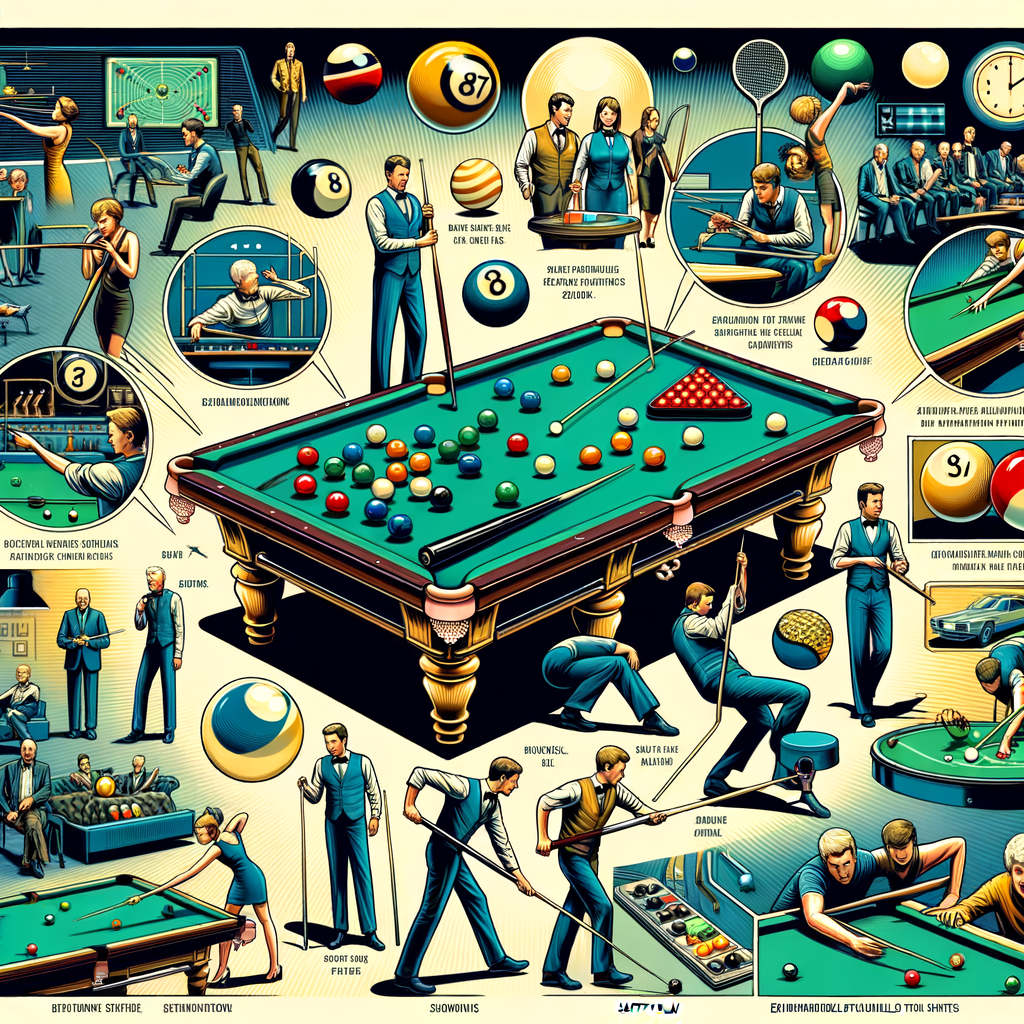
Introduction to Billiards, Pool, and Snooker
Billiards, Pool, and Snooker are all exciting games that involve the use of cues and balls on a table. While they may seem similar at first glance, each game has its unique rules and strategies. In this article, we will explore the basics of these games and highlight their key differences.
- Understanding the basics of the games
Billiards, Pool, and Snooker are all cue sports, which means they are played with a cue stick and balls on a felt-covered table. The aim of these games is to use the cue stick to hit the balls into the pockets of the table. However, the number of balls, their arrangement, and the scoring system vary from one game to another.
Billiards is usually played with three balls: one white, one yellow, and one red. The game involves striking the cue ball with the cue stick so that it hits the other two balls in a single shot.
Pool, on the other hand, is played with a set of 15 balls. The players take turns to hit the balls into the pockets, with the aim of pocketing more balls than their opponent.
Snooker is a bit more complex. It is played with 21 balls: 15 red, and 6 of different colors. The players must first pocket a red ball, followed by a colored ball, and so on.
- Key differences between Billiards, Pool, and Snooker
| Game | Number of Balls | Scoring System |
|---|---|---|
| Billiards | 3 | Points are scored for caroms (when the cue ball hits both other balls) |
| Pool | 15 | Points are scored for each ball pocketed |
| Snooker | 21 | Points are scored for each ball pocketed, with different points for different colors |
While all three games require a high level of skill and precision, they each offer a unique challenge. Whether you prefer the simplicity of Billiards, the strategy of Pool, or the complexity of Snooker, there’s a cue sport for everyone.
History of Billiards, Pool, and Snooker
Let’s take a journey back in time to explore the fascinating history of billiards, pool, and snooker. We’ll start with billiards, a game that has captivated players for centuries.
History of Billiards
Billiards, a game of skill and strategy, has a rich history that dates back hundreds of years. Let’s delve into its origins and evolution, and also learn about some of its most famous players.
-
- Origin and Evolution
The game of billiards originated in 15th century Europe, specifically in France. It started as an outdoor lawn game similar to croquet, and was later moved indoors. The green cloth on the billiard table was meant to represent the grass of the original game. Over the years, the game evolved and gained popularity, with different versions emerging, including English Billiards, American Four-Ball Billiards, and eventually, Pool and Snooker.
-
- Famous Historical Players
Billiards has seen many skilled players throughout its history. One of the most famous is François Mingaud, a French billiards player from the 19th century. He is credited with inventing the leather cue tip, which allows players to apply spin to the ball. Another notable player is Willie Hoppe, an American player who dominated the game in the early 20th century. He won numerous world championships and is remembered as one of the greatest billiards players of all time.
Now that we’ve explored the history of billiards, let’s move on to the history of pool and snooker in the next sections.
History of Pool
Let’s dive into the fascinating history of pool, a game that has captured the hearts of many over the centuries. We’ll look at its origin and evolution, as well as some of the famous players who have left their mark on this game.
- Origin and Evolution
The game of pool, also known as pocket billiards, has a rich history that dates back to the 15th century. It originated in Europe, specifically in France, where it was initially played on a table with a green cloth to mimic a lawn. The game was initially played with a mace, a stick that was used to push the balls, rather than strike them. Over time, the game evolved and the cue stick was introduced, which is used to strike the balls.
Pool made its way to America in the 19th century, where it gained popularity in gambling halls. The game continued to evolve with the introduction of new rules and variations, such as eight-ball and nine-ball, which are the most popular forms of pool today.
- Famous Historical Players
Over the years, pool has seen many great players who have shaped the game. One such player is Willie Mosconi, also known as “Mr. Pocket Billiards”. Mosconi held the world straight pool championship title 15 times, and his record of running 526 consecutive balls in straight pool is still unbeaten.
Another notable player is Rudolf Walter Wanderone, famously known as “Minnesota Fats”. Despite his controversial career, he is considered one of the most recognized pool players in the United States. His flamboyant personality and skillful play made him a household name.
These players, among others, have left a significant impact on the game of pool, inspiring many to pick up a cue and take a shot at this timeless game.
History of Snooker
Snooker is a fascinating game with a rich history. Let’s take a journey back in time to understand its origin and evolution, and learn about some of the famous historical players who have shaped this game.
-
- Origin and Evolution
Snooker was born in the late 19th century. It was invented by British Army officers stationed in India. They combined elements from two popular games of the time, Pyramids and Black Pool, to create a new game that was more challenging and strategic. The name ‘Snooker’ comes from a military term used to describe inexperienced or first-year personnel.
Over the years, Snooker has evolved significantly. The original game had only 15 red balls, compared to 21 in the modern game. The scoring system has also changed, with more points awarded for potting balls in the correct order. Despite these changes, the core principles of strategy and precision have remained the same, making Snooker a timeless game enjoyed by millions around the world.
-
- Famous Historical Players
Many players have left their mark on the history of Snooker, but a few stand out for their exceptional skill and influence on the game. Here are some of the most notable:
| Player | Years Active | Notable Achievements |
|---|---|---|
| Joe Davis | 1927-1964 | First World Champion, won 15 consecutive titles |
| Ray Reardon | 1967-1992 | Six-time World Champion, dominated the 1970s |
| Steve Davis | 1978-2016 | Six-time World Champion, popularized Snooker in the 1980s |
| Stephen Hendry | 1985-2012, 2020-present | Seven-time World Champion, holds record for most ranking titles |
These players, among others, have helped shape Snooker into the game it is today. Their skill, strategy, and sportsmanship continue to inspire new generations of players.
Understanding the Rules
Every game has its own set of rules. Understanding these rules is the first step towards mastering the game. In this section, we will focus on the rules of billiards.
Billiard Rules
Billiards is a game that requires both skill and strategy. It’s not just about hitting the balls with the cue stick. There are specific rules that guide how the game is played, scored, and penalized. Let’s break it down.
-
- How to play Billiard
Billiards is played on a rectangular table covered with a green cloth. The game involves a cue ball and 15 object balls. The objective is to pocket the balls into one of the six pockets of the table using the cue ball. The player who pockets the most balls wins the game. The game begins with a break shot where the player strikes the cue ball to disperse the object balls.
-
- Scoring and penalties
Scoring in billiards is based on the number of balls pocketed. Each ball pocketed counts as one point. However, if a player pockets the cue ball, it’s a foul and the player loses a point. If a player fails to hit any ball during their turn, it’s also a foul. Three consecutive fouls result in a loss of the game. Remember, the player with the most points at the end of the game wins.
Understanding these rules is crucial to playing and enjoying the game of billiards. It’s not just about hitting the balls; it’s about playing strategically and within the rules of the game. So, grab a cue stick, practice your shots, and remember to play fair!
Pool Game Rules
Pool, also known as pocket billiards, is a popular game enjoyed by many people worldwide. To play this game effectively, it’s essential to understand the rules. Let’s dive into the basics of how to play pool and the scoring and penalties involved.
-
- How to Play Pool
Playing pool involves using a cue stick to hit billiard balls, aiming to pocket them in one of the six holes on the pool table. Here’s a simple step-by-step guide:
-
-
- Step 1: Set up the balls in a triangle at one end of the table. The 8-ball should be in the center of the triangle.
- Step 2: Decide who goes first. The first player breaks the triangle of balls using the cue ball.
- Step 3: After the break, players take turns to pocket the balls. The first type of ball (stripes or solids) pocketed by a player becomes their target for the rest of the game.
- Step 4: The game continues until a player pockets all their balls, after which they must pocket the 8-ball to win.
- Scoring and Penalties
-
In pool, scoring is straightforward. Each pocketed ball counts as one point. However, penalties can affect your score. Here are some common penalties:
| Penalty | Consequence |
|---|---|
| Foul shot (e.g., hitting an opponent’s ball first) | Opponent gets ball in hand |
| Pocketing the cue ball | Opponent gets ball in hand |
| Pocketing the 8-ball early | Automatic loss of game |
Remember, understanding the rules is the first step to becoming a proficient pool player. Practice these rules, and you’ll be well on your way to mastering the game of pool.
Snooker Rules
Snooker is a fascinating and strategic game that requires skill and precision. Let’s dive into the rules of this exciting game.
-
- How to Play Snooker
Snooker is played on a large rectangular table covered with green cloth. The game involves 21 object balls – 15 red balls, and 6 colored balls: yellow, green, brown, blue, pink, and black. The aim is to score more points than your opponent by potting balls in a specific order.
Here’s a simple step-by-step guide:
-
-
- Start by setting up the balls on the table in their correct positions.
- Players take turns to strike the white cue ball to pot the other balls.
- The first ball to be potted must be a red one. After a red ball is potted, a player must then pot a colored ball.
- Each ball has a different point value: red (1 point), yellow (2 points), green (3 points), brown (4 points), blue (5 points), pink (6 points), and black (7 points).
- The player continues to alternate between red and colored balls until all the red balls are potted. After that, the colored balls must be potted in ascending order of their points.
- The game ends when all the balls are potted, or when it’s impossible for the other player to win due to lack of points.
- Scoring and Penalties
-
Scoring in snooker is based on the point values of the balls. The player with the highest score at the end of the game wins. However, penalties can affect the score.
Here are some common penalties:
-
-
- If a player pots the wrong ball, it’s a foul and a penalty of 4 points is given to the opponent.
- If a player fails to hit any ball with the cue ball, it’s a foul and a penalty of 4 points is given to the opponent.
- If a player pots the cue ball (known as a ‘scratch’), it’s a foul and a penalty of 4 points is given to the opponent.
-
Remember, the key to winning snooker is not just about potting balls, but also about avoiding penalties and using strategies to make it difficult for your opponent to score.
Game Techniques and Strategies
Mastering the game of billiards requires not only understanding the rules but also learning and applying various techniques and strategies. In this section, we will delve into some basic and advanced billiard techniques, as well as strategies that can help you win games.
Billiard Techniques
Whether you’re a beginner or a seasoned player, understanding and mastering certain billiard techniques can significantly improve your game. Let’s explore some of these techniques.
-
- Basic and advanced techniques
For beginners, the most fundamental technique to master is the ‘cueing action.’ This involves lining up the cue stick with the cue ball and the target ball, then smoothly striking the cue ball. As you progress in your game, you can learn advanced techniques like ‘spin’ and ‘jump shots.’
-
- Strategies for winning
Winning at billiards requires more than just good technique. It also involves strategic thinking. For instance, ‘position play’ is a strategy where you aim to control the cue ball’s position after a shot, setting up for your next shot. Another strategy is ‘safety play,’ where you aim to leave the balls in a position that makes it difficult for your opponent to make a successful shot.
Remember, practice makes perfect. The more you play and apply these techniques and strategies, the better you will become at the game of billiards.
Pool Game Techniques
Playing pool is not just about hitting balls into pockets. It’s a game of strategy, precision, and skill. Let’s dive into some basic and advanced techniques that can help you win your next pool game.
- Basic and Advanced Techniques
Even if you’re a beginner, you can quickly improve your game by mastering a few basic techniques. Let’s start with the fundamentals:
- Stance: Stand with your feet shoulder-width apart, leaning slightly over the table. This gives you balance and control.
- Bridge Hand: This is the hand that supports the cue stick. It should be steady and firm to ensure accurate shots.
- Aiming: Always aim before you shoot. Look at the path the ball will take and visualize it going into the pocket.
Now, let’s move on to some advanced techniques:
- Spin: By hitting the cue ball off-center, you can make it spin in a particular direction after it hits another ball. This is useful for positioning the cue ball for your next shot.
- Jump Shots: This is when you hit the cue ball so it jumps over another ball. It’s a tricky shot, but it can get you out of tight spots.
- Bank Shots: This is when you bounce the ball off the side of the table to get it into a pocket. It requires good understanding of angles and precision.
- Strategies for Winning
Winning at pool is not just about technique, it’s also about strategy. Here are some tips to help you win:
- Plan Ahead: Always think a few shots ahead. This will help you position the cue ball for future shots.
- Play Defense: If you can’t pocket a ball, try to leave the cue ball in a position that makes it difficult for your opponent to make a shot.
- Practice: The more you play, the better you’ll get. Practice different shots and techniques to improve your game.
Remember, pool is a game of patience and precision. By mastering these techniques and strategies, you can become a formidable opponent at the pool table.
Snooker Strategies
Snooker is a game of precision and strategy. It’s not just about potting the balls, but also about planning your shots and controlling the cue ball. Let’s dive into some basic and advanced strategies, as well as strategies for winning.
- Basic and Advanced Strategies
For beginners, the most important thing is to learn how to control the cue ball. This involves understanding how the ball will move after it hits another ball, and how to use spin to change its direction. For example, if you hit the ball in the center, it will move in a straight line. But if you hit it on the side, it will curve.
As you become more advanced, you can start to use more complex strategies. One popular strategy is the “safety shot”. This is when you hit the ball in such a way that it becomes difficult for your opponent to make their next shot. This can give you a big advantage in the game.
- Strategies for Winning
If you want to win at snooker, you need to think several shots ahead. This means you need to plan not just your current shot, but also where the cue ball will end up for your next shot. This is called “position play”.
Another important strategy is to score as many points as possible in one visit to the table. This is known as a “break”. The highest possible break in snooker is 147, which is achieved by potting all 15 reds with 15 blacks for 120 points, followed by all six colors for a further 27 points.
Remember, practice makes perfect. The more you play, the better you will become at using these strategies. So grab your cue and start practicing!
Equipment and Setup
Understanding the right equipment and how to set it up is a crucial part of playing billiards. Let’s dive into the essential billiard equipment and how to care for it.
Billiard Equipment
Billiards is a game that requires specific equipment to play. Without these, the game would not be possible. Let’s take a closer look at what you need.
-
- Essential equipment for playing
The basic equipment needed for a game of billiards includes a billiard table, billiard balls, and a cue stick. The table is usually made of slate and covered with a green cloth. The balls are typically made of phenolic resin, and there are 15 of them, each with a different color and number. The cue stick, used to hit the balls, is usually made of wood or fiberglass.
-
- How to maintain and care for your equipment
Proper care and maintenance of your billiard equipment can prolong its life and improve your game. For the table, regular brushing of the cloth can prevent the accumulation of dust and chalk. The balls should be cleaned with a soft cloth and mild soap, and the cue stick should be kept straight and clean. Avoid exposing your equipment to extreme temperatures as it can cause damage.
Remember, the quality of your equipment can significantly impact your game. Therefore, investing in good quality equipment and taking care of it can enhance your billiards experience.
Pool Table Setup
Setting up a pool table correctly is crucial for a fair and enjoyable game. Here, we will guide you through the process and provide tips for maintaining your table.
-
- How to properly set up a pool table
Setting up a pool table involves several steps. Let’s break them down:
-
-
- Positioning: The table should be placed in a room where there’s enough space to move around and play without obstructions.
- Leveling: Use a carpenter’s level to ensure the table is perfectly horizontal. This is important as an unlevel table can affect the roll of the balls.
- Installing the felt: The felt should be stretched and secured tightly to the table. Any wrinkles or loose areas can interfere with the game.
- Setting up the rails and pockets: Attach the rails and pockets according to the manufacturer’s instructions. Ensure they are secure and aligned correctly.
- Placing the balls: The balls should be set up in a triangle formation at the foot of the table, with the 8-ball at the center of the third row.
- Tips for maintaining your table
-
Maintaining your pool table can extend its lifespan and improve your gaming experience. Here are some tips:
-
- Cleaning: Regularly clean the felt with a brush or vacuum to remove dust and chalk residue.
- Protection: Use a table cover when not in use to protect the felt from spills, dust, and sunlight.
- Rotation: Rotate the direction of play periodically to ensure even wear on the table.
- Professional maintenance: Consider hiring a professional for periodic maintenance, especially for tasks like leveling and replacing the felt.
Remember, a well-set and maintained pool table can greatly enhance your game. So, take the time to set up your table correctly and keep it in top condition.
Snooker Equipment
Snooker is a game of precision, strategy, and skill. To play it well, you need the right equipment. Let’s explore the essential gear for playing snooker and how to maintain it.
-
- Essential Equipment for Playing
Here are the key pieces of equipment you need to play snooker:
-
-
- Snooker Table: A full-size snooker table is 12 feet by 6 feet. It has six pockets and is covered in green baize.
- Snooker Balls: A set of snooker balls includes 15 red balls, 6 colored balls (yellow, green, brown, blue, pink, black), and a white cue ball.
- Cue: The cue is a long, tapered stick used to strike the cue ball. It’s typically made of wood, but can also be made of fiberglass or carbon fiber.
- Chalk: Chalk is used to increase the friction between the cue tip and the ball, improving accuracy and control.
- Triangle: This is used to arrange the red balls in a triangle at the start of the game.
- How to Maintain and Care for Your Equipment
-
Proper maintenance of your snooker equipment can extend its lifespan and enhance your game. Here are some tips:
-
- Snooker Table: Regularly brush the baize to keep it clean and free of dust. Use a cover when the table is not in use to protect it from dust and sunlight.
- Snooker Balls: Clean them with a soft cloth and warm soapy water. Dry them thoroughly before storing to prevent moisture damage.
- Cue: Keep your cue in a case when not in use to protect it from warping and damage. Regularly clean the cue with a damp cloth and dry it thoroughly.
- Chalk: Use it sparingly to avoid build-up on the cue tip and the baize.
With the right equipment and proper care, you can enjoy many games of snooker and continually improve your skills.
Conclusion: Snooker vs Pool vs Billiards
As we wrap up our exploration of these three fascinating games, it’s time to compare them side by side and help you decide which one might be the best fit for you. Let’s dive into the pros and cons of each game and consider some factors to guide your choice.
- Comparing the games: pros and cons
Each of these games has its unique appeal, challenges, and rewards. Here’s a quick comparison:
| Game | Pros | Cons |
|---|---|---|
| Snooker | Offers strategic gameplay and requires precision. It’s a game of patience and concentration. | It can be complex for beginners due to its rules and larger table size. |
| Pool | Easy to learn, fast-paced, and offers various game types. It’s great for socializing. | It may lack the depth and strategic element found in Snooker and Billiards. |
| Billiards | It’s a classic game that emphasizes skill over luck. It has fewer balls, making it less cluttered. | The absence of pockets can make it challenging for new players. |
- Choosing the right game for you
When choosing the right game for you, consider your preferences and what you’re looking for in a game. If you enjoy a fast-paced, social game, Pool might be your best bet. If you appreciate a game of strategy and patience, Snooker could be a great fit. And if you’re looking for a classic game that emphasizes skill, you might enjoy Billiards.
Remember, the best way to decide is to give each game a try. You might find you enjoy one more than you expected. No matter which game you choose, the most important thing is to have fun and enjoy the challenge.














